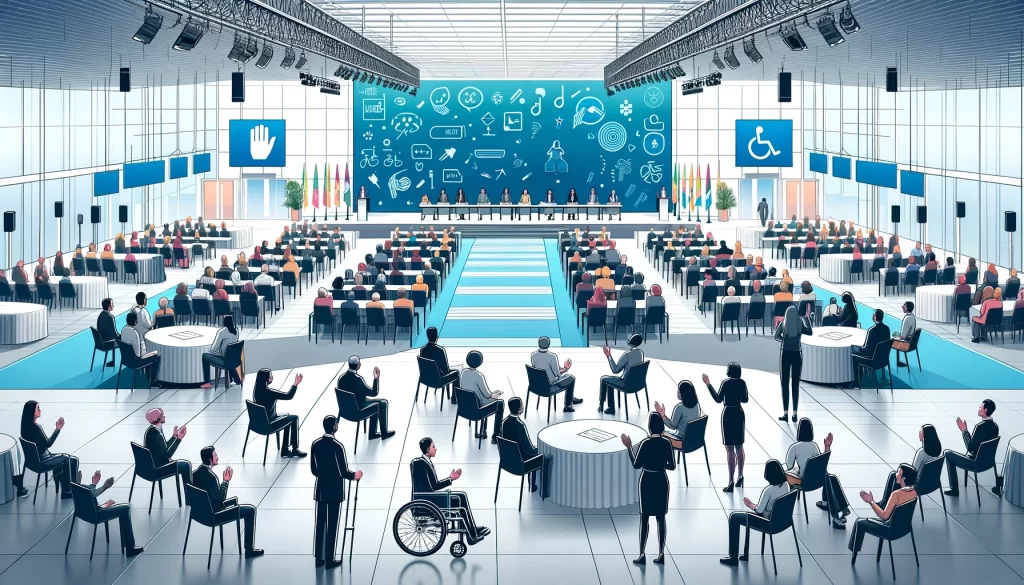Illustration depicting accessible conferences with guests of all abilities.
Creating inclusive and accessible conferences and events is crucial for allowing all attendees to fully participate and enjoy the experience. This comprehensive article offers insights and practical steps towards this goal. It emphasizes considering various needs, from physical to sensory accommodations, and involves actively engaging with communities to understand diverse perspectives. By doing so, events can become spaces where inclusivity is not just an afterthought but a foundational element, enriching the experience for everyone and setting new standards for event planning.
Understanding the Importance of Inclusivity and Accessibility
The first step in creating inclusive events is understanding why it matters. Accessibility is not just about physical access but includes cognitive, auditory, and visual considerations. It’s about creating an environment where everyone feels welcome and valued.
Hiring consultants with disabilities to help plan and execute events is crucial. Their personal insights and experiences are invaluable in understanding true accessibility and inclusivity. Their involvement ensures that events are designed with a profound understanding of diverse needs, making them genuinely accommodating. This inclusive staffing approach not only enhances event accessibility but also underscores a commitment to diversity and representation. Additionally, it promotes a culture of empathy and understanding, encouraging participants to adopt a more inclusive perspective in their daily lives and professional environments.
Pre-Event Planning For Accessible Conferences
- Venue Selection: The venue should be easily accessible by public transportation and have parking spaces for people with disabilities. Check for Braille signage and ensure auditory signals are in place for the visually impaired.
- Digital Accessibility: Regularly test your website’s accessibility with various tools and seek feedback from users with disabilities. Ensure all videos have subtitles and that the registration process is straightforward and accommodating.
- Inclusive Marketing: Use language in your marketing materials that reflects a commitment to diversity and inclusivity. Clearly specify contact information for accessibility inquiries.
Accessible Transportation Options
- Dedicated Shuttle Services: Offer shuttle services equipped with accessibility features like wheelchair lifts or ramps. Ensure these shuttles run frequently and connect key transportation hubs to the event venue.
- Partnerships with Accessible Taxi Services: Collaborate with taxi companies that have vehicles adapted for wheelchair users or those with mobility issues, providing attendees with reliable and comfortable transportation options.
- Clear Transportation Information: Provide detailed information on accessible public transportation routes and services. Include maps and schedules on the event website and in the event guide, and offer assistance for booking and navigating these services.
During the Event
- Sign Language Interpreters and Captioning Services: Position interpreters where they can be easily seen, and ensure the captioning is accurate and timely. Regular breaks for interpreters are necessary for prolonged events. ADA requirements for effective communication can be seen here.
- Audio Descriptions: Provide individual receivers for audio descriptions to avoid disturbance to other attendees. Ensure narrators are skilled in vividly describing the visual elements.
- Sensory Considerations: Offer detailed descriptions of the sensory environment in pre-event communications. Include noise levels, lighting types, and scent-related information.
- Diverse Representation: Actively seek out and invite speakers and panelists with disabilities. Ensure that their accommodation needs are fully met.
Staff and Volunteer Training
- Awareness and Sensitivity Training: Include role-play scenarios in training to better prepare staff for real-world interactions. Provide a comprehensive guide on disability etiquette.
Post-Event Feedback
- Gather Feedback: Use various formats for feedback collection, such as online surveys, phone interviews, and in-person discussions, to accommodate different communication preferences.
- Continual Improvement: Stay abreast of the latest developments in accessible technology and incorporate them into future events. Build a network with organizations focused on inclusivity for continuous learning.
The Long-term Benefits
Creating inclusive and accessible conferences and events goes beyond compliance. It demonstrates social responsibility, enhances the reputation of your organization, and contributes to a more inclusive society. By following these steps, you can ensure that your event is not only successful but also a positive experience for all attendees.
Having your event or conference facility assessed by Equal Accessibility® for inclusivity and accessibility is vital. This assessment transcends legal compliance; it’s about truly welcoming everyone. An evaluation can reveal unseen barriers and suggest solutions, ensuring a comfortable and memorable experience for all guests. This commitment to accessibility reflects deep respect for diversity and enhances your venue’s reputation in the community. It also sets a standard, encouraging others to prioritize inclusivity and fostering a wider understanding and acceptance of diverse needs in public spaces.


